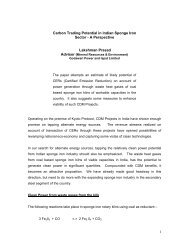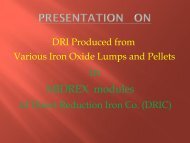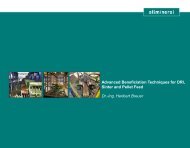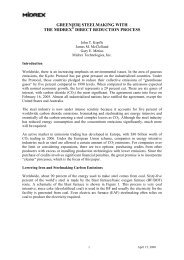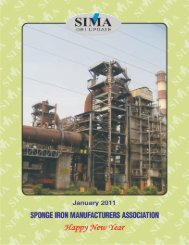You also want an ePaper? Increase the reach of your titles
YUMPU automatically turns print PDFs into web optimized ePapers that Google loves.
iv) Overall Demand- Supply Gap (MMSCMD)<br />
<strong>2007</strong>-08 2008-09 2009-10 2010-11 2011-12<br />
SUPPLY<br />
Domestic 80.54 119.98 115.97 113.09 108.30<br />
LNG 30.45 33.60 52.50 70.00 83.12<br />
TOTAL:<br />
DEMAND<br />
110.99 153.58 168.47 183.09 191.42<br />
Demand 178.97 196.39 221.86 265.16 282.55<br />
GAP 67.98 42.81 53.39 82.07 91.13<br />
� It will be observed that scenario indicated above<br />
reflects significant deficit which will have to be met<br />
either from increased domestic supplies or LNG<br />
import or both.<br />
� There is another scenario where there is a possible<br />
additional domestic supply for 2009-10 (74<br />
MMSCMD), 2010-11 (84 MMSCMD) and 2011-12 (94<br />
MMSCMD). If such supplies materialize than from<br />
2009-10 onwards there will not be any deficit but<br />
there will be little surplus. These additional quantities<br />
have been estimated by DGH as 20, 30 and 40<br />
MMSCMD from Reliance fields from 2009-10, 2010-<br />
11 and 2011-12 respectively. 54 MMSCMD has been<br />
estimated from GSPC in each of above years.<br />
� How much of these additional supplies, which<br />
turn the deficit into surplus, will actually fructify<br />
is dependent on several factors yet to be firmed<br />
up.<br />
Conclusion<br />
India currently produces 90 MMSCMD of Gas against<br />
the demand of over 151 MMSCMD. For many years India<br />
continues to be deficit in supply of natural gas as the<br />
availability has been limited and therefore Government<br />
had adopted the system of allocations and administered<br />
price mechanism. With the new developments like import<br />
of LNG and new finds of domestic gas in KG basin the<br />
availability of natural gas / LNG is expected to go up<br />
significantly while at the same time the existing sources<br />
of supply from Bombay High etc. which are depleting will<br />
affect overall availability. The significant new finds from<br />
KG Basin yet to be monetized as the development work<br />
at wells continues and pipeline infrastructure to bring the<br />
gas on land is taking shape. The supplies from KG Basin<br />
are expected from Reliance, ONGC, GSPC and British<br />
Gas. Out of these players Reliance is expected to begin<br />
supplies sometimes in 2 nd quarter of 2008, and if everything<br />
goes well then the quantum of supplies that is expected<br />
will be around 40 MMSCMD. Though Reliance have<br />
claimed that they can supply upto 80 MMSCMD but the<br />
same has not been confirmed by DGH. The certified<br />
reserves for Reliance by Gaffiney, Cline and Associates<br />
have put recoverable reserves at 11.3 TCF. This would<br />
confirm supplies only upto 40 MMSCMD. Future factors<br />
which will drive demand and prices would be dependant<br />
upon (i) KG Basin supplies (ii) Long term LNG availability.<br />
Current estimate indicate potential demand of around 20<br />
MMSCMD for City Gas Distribution (CGD) along the<br />
existing pipeline routes. This demand is potentially<br />
favorable Vis-Vis alternate fuels. Spot LNG volumes in<br />
2006 are a landmark for Indian market. The regassifiers<br />
Petronet and Shell imported significant number of cargo’s<br />
to meet the demand from Power, Steel and Fertilizer<br />
sectors. The imports could have been more but for the<br />
restricted availability of spot cargo’s which were priced<br />
from $8 to $11 per MMBTU. It appears that in future also<br />
India would need to compete with more attractive<br />
markets. The challenge is to bring domestic gas to<br />
production and source LNG on long term basis. Gas<br />
markets would continue to be driven by existing<br />
customers in the medium term. Power and Fertilizer will<br />
be major sector consuming gas. LNG and new domestic<br />
discoveries will compete for the incremental demand. Gas<br />
will continue to be priced at a value “compared to alternate<br />
options” till the time there is ‘gas to gas’ competition in<br />
the market with significantly large volumes from domestic<br />
sources. Competitive claims of other consumers both in<br />
public and private sector may lead to some kind of<br />
allocation by Government for Power and Fertilizer sector.<br />
No clarity at present of additional supplies claimed by<br />
Reliance and GSPC. Reserve certification and DGH<br />
approval yet to happen. Producers from KG Basin may<br />
manage production to keep prices in the vicinity of<br />
international price. In view of overall deficit our additional<br />
requirements may not be fully met from domestic sources.<br />
MAY-<strong>2007</strong>/15




